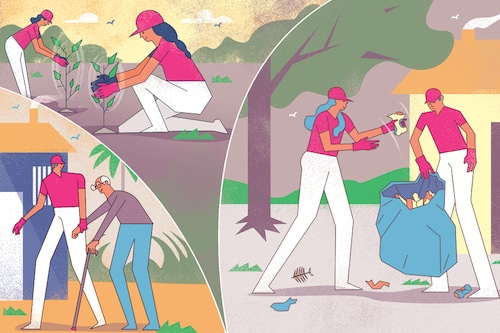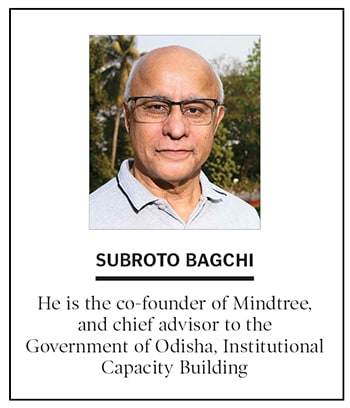Thriving volunteer activity can become a major organisational strength: Subroto
Businesses can build stronger reputational capital and have happier employees by allowing them to engage with and help communities, writes the co-founder of Mindtree


 The word ‘philanthropy’ has its origin in the Greek words ‘philos’ and ‘anthropos’. Philos means love. Anthropos means man. Thus, an act of philanthropy is about loving fellow humans. Philosophers, scholars and scientists admit that most individuals are wired with some degree of care, concern and love for fellow beings. It is in our basic nature. That is how we have survived many natural and man-made upheavals to be here today. As business leaders and entrepreneurs, we need to appreciate the integrity between being human and doing good. That is where we must start.
The word ‘philanthropy’ has its origin in the Greek words ‘philos’ and ‘anthropos’. Philos means love. Anthropos means man. Thus, an act of philanthropy is about loving fellow humans. Philosophers, scholars and scientists admit that most individuals are wired with some degree of care, concern and love for fellow beings. It is in our basic nature. That is how we have survived many natural and man-made upheavals to be here today. As business leaders and entrepreneurs, we need to appreciate the integrity between being human and doing good. That is where we must start.
But today, I want to talk about why and how philanthropy makes institutional and business sense. For this, I want to take you back to 1990, when I came to the US for the first time. Coming from India of the time, I realised that large scale Indian philanthropy was different from how it was in the US. In India of the time, individuals seldom gave away “personal" wealth for public good. “Industrialists" gave company money for charity, building temples and dharmashalas. Exceptions were, of course, there like the Tatas, Birlas and Shrirams who built abiding institutions in education, and in the cultural arena. In the US, even in small towns, there were individuals who were not “industrialists" but they owed big to their community and left behind their money in substantial amounts. That built America in no small measure.
The second interesting aspect was a difference in engagement at the organisational level. In India, all philanthropy was done by the owner of the business. Lalaji or Sethji chose the cause, the money, the effort, even the statue and the garland. People in the company had no role to play. In the US, business leaders enabled their organisations to be platforms for their employees to pursue community engagement. This model harnessed individual volunteerism, aggregated its power at an organisation level and directed the effort to make external impact. The organisation (owners) did not dictate for what good the efforts would be used. Employees worked in a self-directed manner. They were allowed to involve families and other stakeholders.
The question that came to my mind was why the American model was so different? Two things struck me as distinctive. First, there is always a personal story behind an owner or CEO that shaped their mindset to give. The second was how they saw volunteerism as a great organisational strength. I want to fleetingly dwell on the first part, but spend more time on the second.
Unlike today’s India where we are witnessing a surge in first-generation entrepreneurs, I grew up in a country where entrepreneurship was a matter of lineage.
Also read: Ashok Soota: Thinking big and taking path less travelled, even with philanthropy
Companies were owned by families who often treated the company’s wealth as their personal wealth. In contrast, most American business owners were first-generation entrepreneurs. Their upbringing in most cases was so ordinary that they were inherently grateful for being where they were and constantly reminded themselves about it. Such a thing makes people develop a sense of gratitude to others who have helped in ways big and small in one’s personal success. As a result, there is a sense of indebtedness. It is a burden that these individuals constantly carry, telling them every day that the favour must be returned.
Now let us shift to the concept from individual philanthropy to making the organisation a platform for social impact through volunteerism. Organisations are made up of people. People are like bees. Bees do not just work in the hives. They live there. Even as it may not feel so to many, we do not just work at the workplace. We live there. A massive part of our life is spent at work. In the hive, bees constantly communicate with each other, share work and defend themselves collectively. They live as a “community".
Organisations are essentially communities. If we dig further, we will quickly understand that they are, in fact, a community of communities. People at work seek common interest, create networks, build support systems, alliances, and many of these become thriving communities. Strangely, these communities may not be apparent to people at the helm. Behaviouralists explain this phenomenon as the “hetroarchy" as against the hierarchy. These are forces present and potent but do not show up in the org chart they are alive in the blank spaces. These communities are powerful and unlike the creatures in the org chart, they are a volunteer force. Many companies consciously become platforms for such people for larger social good. When an organisation says use the cafeteria space, the bulletin board, the computer network and the conference rooms and auditorium when empty and the parking lot during the weekend, to gather and discuss, connect with, and contribute to local communities, magic happens.
And what happens when volunteer activity thrives in the organisation? It works perceptively at three levels. First, thanks to the “wired for altruism" argument that I marshalled in the beginning, the human brain gets an extra helping of dopamine as they engage in community interaction. It improves self-worth. Plainly put, employees that engage as members of a community and work for social good are more likely to be happy and happiness is contagious. The second thing is volunteerism is a power. At the core of it lies the idea of initiative. HR folks speak about it as a critical leadership quality. Volunteers do not have to be told what it means. When people volunteer, they become initiators. This becomes a major organisational strength.
The third thing about volunteering is it builds reputational capital for the business itself. When a company is well loved by local communities, it does impact the ticker tape. But ticker tape apart, a happy, innovative workforce brings in like-minded ones, builds barriers to easy exit and attracts higher quality of suppliers and customers.
First Published: Feb 14, 2024, 16:34
Subscribe Now